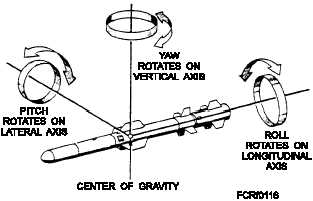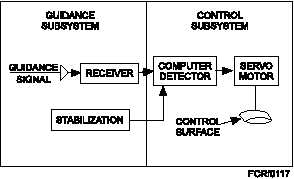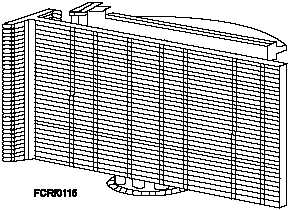secondary air-search radars; in emergencies,
fire-control radars have served as surface-search
radars. A multi-dimensional air-search radar is shown
in figure 1-15.
MISSILE GUIDANCE RADAR
The purpose of a guidance subsystem is to direct
the missile to target intercept regardless of whether or
not the target takes deliberate evasive action.
The
guidance function may be based on information
provided by a signal from the target, information sent
from the launching ship, or both.
Every missile
guidance system consists of two separate systems—an
attitude control system and a flight path control
system.
The attitude control system maintains the
missile in the desired attitude on the ordered flight path
by controlling it in pitch, roll, and yaw (fig. 1-16). This
action, along with the thrust of the rocket motor, keeps
the missile in stabilized flight. The flight path control
system guides the missile to its designated target. This
is done by determining the flight path errors,
generating the necessary orders needed to correct these
errors, and sending these orders to the missile’s control
subsystem. The control subsystem exercises control in
such a way that a suitable flight path is achieved and
maintained. The operation of the guidance and control
subsystems is based on the closed-loop or servo
principle (fig. 1-17). The control units make corrective
adjustments to the missile control surfaces when a
guidance error is present. The control units also adjust
the wings or fins to stabilize the missile in roll, pitch,
and yaw. Guidance and stabilization are two separate
processes, although they occur simultaneously.
Phases of Guidance
Missile guidance is generally divided into three
phases (fig. 1-18). As indicated in the figure, the three
p h a s e s a r e
b o o s t , m i d c o u r s e ,
a n d
t e r m i n a l .
STANDARD SM-2 missiles (MR & ER) use all three
of these phases. Not all missiles, however, go through
the three phases.
As shown in figure 1-18, some
missiles (STANDARD SM-1, SEASPARROW) do
not use midcourse guidance.
With that thought in
mind, let’s examine each phase, beginning with boost.
I N I T I A L
( B O O S T )
P H A S E . — N a v y
surface-launched missiles are boosted to flight speed
by the booster component (which is not always a
separate component) of the propulsion system. The
boost period lasts from the time the missile leaves the
launcher until the booster burns up its fuel. In missiles
with separate boosters, the booster drops away from
the missile at burnout (fig. 1-18, view A). Discarding
the burnt-out booster shell reduces the drag on the
missile and enables the missile to travel farther. SMS
missiles with separate boosters are the STANDARD
(ER) and HARPOON.
The problems of the initial (boost) phase and the
methods of solving them vary for different missiles.
The method of launch is also a factor.
The basic
purposes, however, are the same. The missile can be
either pre-programmed or physically aimed in a
specific direction on orders from the fire control
1-14
Figure 1-16.—Missile axes: pitch, roll, yaw.
Figure 1-17.—Basic missile guidance and control systems.
Figure 1-15.—Multi-dimensional (3-D) radar.






